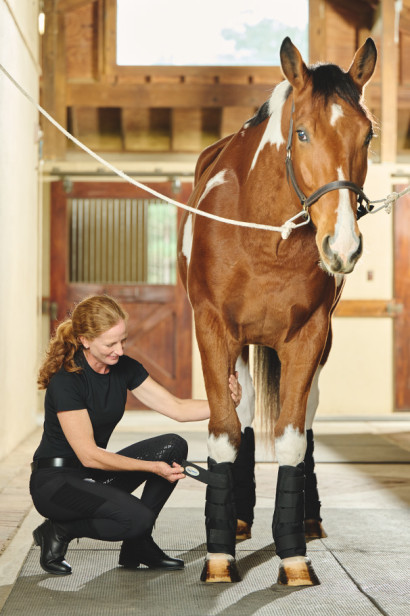Whatever You Need to Understand About Equine Therapy for Mental Wellness
Reviewing the Efficiency of Laser Treatment in Equine Therapy for Injury Rehabilitation
The examination of laser therapy's efficiency in equine injury recovery rests on numerous factors, consisting of recovery time, pain reduction, and tissue regrowth. Clinical research studies recommend noteworthy improvements in conditions like tendonitis and osteo arthritis, credited to enhanced mobile function and elevated ATP production. Vets frequently observe superior results with laser treatment contrasted to conventional techniques, placing it as a crucial element in equine care. Nevertheless, the need for continual monitoring and customized treatment plans can not be overemphasized. What particular medical proof sustains these insurance claims, and just how do vets apply these methods in technique?
Recognizing Laser Treatment
Laser treatment has become a pivotal tool in vet medication, especially in the treatment of equine conditions. Recognized for its non-invasive nature and effectiveness, laser therapy involves the application of specific wavelengths of light to boost cells repair work and decrease swelling. This healing technique is increasingly preferred for its capacity to speed up the healing procedure in equines dealing with a selection of bone and joint injuries and chronic problems.
The primary system behind laser treatment is its ability to improve mobile features. Additionally, laser therapy advertises vasodilation, improving blood flow and oxygen shipment to broken cells, thus accelerating recuperation.
In equine medication, laser therapy is particularly helpful for problems such as tendonitis, osteo arthritis, and wound healing. The method is lauded for its pain-relieving residential or commercial properties, enabling equines to reclaim mobility and function more rapidly. Veterinarians likewise appreciate its very little adverse effects contrasted to various other therapy methods, making it a reliable and safe option for equine care.

How Laser Therapy Functions

Upon absorption, these photons activate a series of biochemical changes, enhancing mitochondrial feature and causing enhanced adenosine triphosphate (ATP) production. This increase in ATP accelerates mobile metabolic rate, promoting tissue fixing and regeneration. Additionally, laser treatment modulates inflammatory responses by influencing cytokine levels and lowering oxidative anxiety, thus reducing discomfort and swelling.
One more substantial element of laser therapy is its function in enhancing microcirculation. The treatment promotes vasodilation, boosting blood flow and oxygen distribution to damaged cells (Equine Therapy). This helps with the elimination of cellular particles and supports the expansion of fibroblasts click here to read and collagen synthesis, essential for injury healing
Scientific Evidence
The effectiveness of laser therapy in equine therapy has actually been validated through numerous scientific studies, showcasing its restorative possible across a variety of problems. Several regulated tests and observational research studies have actually documented considerable improvements in tissue repair service, discomfort reduction, and general recovery timelines. A research study performed by Turner et al. (2012) demonstrated that horses treated with low-level laser therapy (LLLT) for ligament injuries showed increased healing compared to those getting traditional therapies. The research highlighted a significant decrease in inflammation and enhanced internet collagen formation.
In a similar way, research study by Johnson and colleagues (2015) concentrated on equine muscle mass injuries, revealing that laser treatment considerably quickened muscle mass fiber regeneration and minimized muscle rigidity. Medical analyses have revealed that laser therapy can relieve chronic problems such as osteoarthritis.
Vet Insights

Vets additionally value the versatility of laser therapy. It can be employed for a variety of conditions, from shallow wounds to deeper musculoskeletal injuries. Dr. Emily Brown highlights its utility in treating conditions like tendonitis and osteoarthritis, where conventional therapies frequently fail. She explains that laser therapy can be tailored to the specific demands of each steed, making certain optimum end results.
Additionally, veterinarians value the ability to integrate laser treatment with various other treatment modalities. This multimodal strategy can boost general treatment efficiency, giving a detailed option for equine rehabilitation. Such recommendations from skilled experts underscore the expanding acceptance and application of laser therapy in equine medication.
Practical Considerations
A key facet of executing laser therapy in equine therapy involves recognizing the functional considerations that guarantee its effectiveness and safety. It is vital to select the ideal laser device, as numerous types vary in wavelength, power, and penetration deepness. Vets need to be fluent in these specifications to customize treatment methods efficiently per injury type
Additionally, the regularity and duration of laser treatment sessions need cautious preparation to make best use of therapeutic advantages while minimizing any type of possible unfavorable impacts. Regular monitoring of the equine's feedback to treatment can assist essential adjustments in the treatment routine. Establishing a risk-free and regulated atmosphere throughout therapies is also important to protect against unintentional exposure to laser discharges, which can harm both the horse and the handler.
Training and qualification of employees administering laser therapy are navigate to these guys critical to make sure correct strategy and to copyright safety standards. Furthermore, preserving precise documents of each session, consisting of laser setups and observed end results, is vital for evaluating the overall effectiveness of the treatment and for making data-driven decisions.
Conclusion
Laser therapy has emerged as an effective modality in equine injury rehabilitation, offering substantial benefits in recovery time, discomfort alleviation, and cells recovery. Scientific research studies highlight considerable enhancements in conditions such as tendonitis and osteoarthritis, attributed to enhanced mobile feature and boosted ATP production. Veterinarian observations corroborate these findings, highlighting superior end results contrasted to standard therapies. For optimal outcomes, continual tracking and personalized treatment methods continue to be necessary in leveraging the full potential of laser treatment in equine treatment.